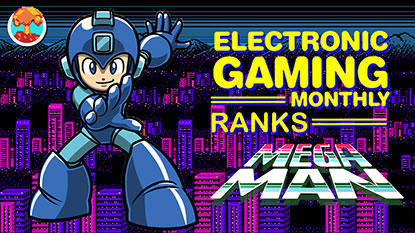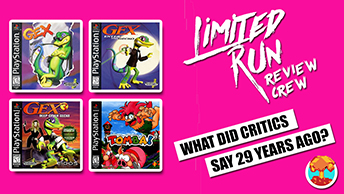- CLASSIC MAGAZINES
- REVIEW CREW
A show recapping what critics thought back
when classic games first came out! - NEXT GENERATION'S BEST & WORST
From the worst 1-star reviews to the best
5-stars can offer, this is Next Generation! - NINTENDO POWER (ARCHIVE)
Experience a variety of shows looking at the
often baffling history of Nintendo Power! - MAGAZINE RETROSPECTIVE
We're looking at the absolutely true history of
some of the most iconic game magazines ever! - SUPER PLAY'S TOP 600
The longest and most ambitious Super NES
countdown on the internet! - THEY SAID WHAT?
Debunking predictions and gossip found
in classic video game magazines! - NEXT GENERATION UNCOVERED
Cyril is back in this spin-off series, featuring the
cover critic review the art of Next Generation! - HARDCORE GAMER MAGAZING (PDF ISSUES)
Download all 36 issues of Hardcore Gamer
Magazine and relive the fun in PDF form!
- REVIEW CREW
- ELECTRONIC GAMING MONTHLY
- ELECTRONIC GAMING MONTHLY RANKS
From Mario to Sonic to Street Fighter, EGM
ranks classic game franchises and consoles! - ELECTRONIC GAMING MONTHLY BEST & WORST
Counting down EGM’s best and worst reviews
going year by year, from 1989 – 2009! - ELECTRONIC GAMING BEST & WORST AWARDS
11-part video series chronicling the ups and
downs of EGM’s Best & Worst Awards!
- ELECTRONIC GAMING MONTHLY RANKS
- GAME HISTORY
- GAME OVER: STORY BREAKDOWNS
Long-running series breaking down game
stories and analyzing their endings! - A BRIEF HISTORY OF GAMING w/ [NAME HERE]
Real history presented in a fun and pithy
format from a variety of game historians! - THE BLACK SHEEP
A series looking back at the black sheep
entries in popular game franchises! - INSTANT EXPERT
Everything you could possibly want to know
about a wide variety of gaming topics! - FREEZE FRAME
When something familiar happens in the games
industry, we're there to take a picture! - I'VE GOT YOUR NUMBER
Learn real video game history through a series
of number-themed episodes, starting at zero! - GREAT MOMENTS IN BAD ACTING
A joyous celebration of some of gaming's
absolute worst voice acting!
- GAME OVER: STORY BREAKDOWNS
- POPULAR SHOWS
- DG NEWS w/ LORNE RISELEY
Newsman Lorne Riseley hosts a regular
series looking at the hottest gaming news! - REVIEW REWIND
Cyril replays a game he reviewed 10+ years
ago to see if he got it right or wrong! - ON-RUNNING FEUDS
Defunct Games' longest-running show, with
editorials, observations and other fun oddities! - DEFUNCT GAMES QUIZ (ARCHIVE)
From online quizzes to game shows, we're
putting your video game knowledge to the test!- QUIZ: ONLINE PASS
Take a weekly quiz to see how well you know
the news and current gaming events! - QUIZ: KNOW THE GAME
One-on-one quiz show where contestants
find out if they actually know classic games! - QUIZ: THE LEADERBOARD
Can you guess the game based on the classic
review? Find out with The Leaderboard!
- QUIZ: ONLINE PASS
- DEFUNCT GAMES VS.
Cyril and the Defunct Games staff isn't afraid
to choose their favorite games and more! - CYRIL READS WORLDS OF POWER
Defunct Games recreates classic game
novelizations through the audio book format!
- DG NEWS w/ LORNE RISELEY
- COMEDY
- GAME EXPECTANCY
How long will your favorite hero live? We crunch
the numbers in this series about dying! - VIDEO GAME ADVICE
Famous game characters answer real personal
advice questions with a humorous slant! - FAKE GAMES: GUERILLA SCRAPBOOK
A long-running series about fake games and
the people who love them (covers included)! - WORST GAME EVER
A contest that attempts to create the worst
video game ever made, complete with covers! - LEVEL 1 STORIES
Literature based on the first stages of some
of your favorite classic video games! - THE COVER CRITIC
One of Defunct Games' earliest shows, Cover
Critic digs up some of the worst box art ever! - COMMERCIAL BREAK
Take a trip through some of the best and
worst video game advertisements of all time! - COMIC BOOK MODS
You've never seen comics like this before.
A curious mix of rewritten video game comics!
- GAME EXPECTANCY
- SERIES ARCHIVE
- NINTENDO SWITCH ONLINE ARCHIVE
A regularly-updated list of every Nintendo
Switch Online release, plus links to review! - PLAYSTATION PLUS CLASSIC ARCHIVE
A comprehensive list of every PlayStation
Plus classic release, including links! - RETRO-BIT PUBLISHING ARCHIVE
A regularly-updated list of every Retro-Bit
game released! - REVIEW MARATHONS w/ ADAM WALLACE
Join critic Adam Wallace as he takes us on a
classic review marathon with different themes!- DEFUNCT GAMES GOLF CLUB
Adam Wallace takes to the links to slice his way
through 72 classic golf game reviews! - 007 IN PIXELS
Adam Wallace takes on the world's greatest spy
as he reviews 15 weeks of James Bond games! - A SALUTE TO VAMPIRES
Adam Wallace is sinking his teeth into a series
covering Castlevania, BloodRayne and more! - CAPCOM'S CURSE
Adam Wallace is celebrating 13 days of Halloween
with a line-up of Capcom's scariest games! - THE FALL OF SUPERMAN
Adam Wallace is a man of steel for playing
some of the absolute worst Superman games! - THE 31 GAMES OF HALLOWEEN
Adam Wallace spends every day of October afraid
as he reviews some of the scariest games ever! - 12 WEEKS OF STAR TREK
Adam Wallace boldly goes where no critic has
gone before in this Star Trek marathon!
- DEFUNCT GAMES GOLF CLUB
- DAYS OF CHRISTMAS (ARCHIVE)
Annual holiday series with themed-episodes
that date all the way back to 2001!- 2015: 30 Ridiculous Retro Rumors
- 2014: 29 Magazines of Christmas
- 2013: 29 Questionable Power-Ups of Christmas
- 2012: 34 Theme Songs of Christmas
- 2011: 32 Game Endings of Christmas
- 2010: 31 Bonus Levels of Christmas
- 2009: 30 Genres of Christmas
- 2008: 29 Controls of Christmas
- 2007: 34 Cliches of Christmas
- 2006: 33 Consoles of Christmas
- 2005: 32 Articles of Christmas
- 2004: 31 Websites of Christmas
- 2003: 29 Issues of Christmas
- 2002: 28 Years of Christmas
- 2001: 33 Days of Christmas
- NINTENDO SWITCH ONLINE ARCHIVE
- REVIEW ARCHIVE
- FULL ARCHIVE
Nintendo Power's Worst Reviewed Games of 1992
The year is 1992. The nuclear family is mad about Mad About You, critics are too grown up to enjoy Robin Williams in Toys and somebody call a doctor, because Billy Ray Cyrus has an Achy Breaky Heart. But there's no time to think about the sex moves that led to Miley Cyrus, because today we're counting down Nintendo Power's five worst games of 1992.




 Well, that was dumb. But if you want to see more content like this, please make sure and subscribe to our fledgling YouTube channel. We're posting reviews, essays, playthroughs and contents every week, and it sure would be nice if you joined the conversation.
Well, that was dumb. But if you want to see more content like this, please make sure and subscribe to our fledgling YouTube channel. We're posting reviews, essays, playthroughs and contents every week, and it sure would be nice if you joined the conversation.

Swamp Thing#5By 1992, some of the shine had worn off the Game Boy. While Nintendo and their third parties managed to release hits like Super Mario Land 2, Bionic Commando and Kirby's Dream Land, most of the lineup was unspectacular. It was a year made up of mainly shrunken ports and licensed games, none of which impressed the critics at Nintendo Power. Published by THQ, Swamp Thing was emblematic of the kind of game you saw on Game Boy in 1992. This ugly platformer was a big miss with Nintendo Power. They were underwhelmed by the gameplay and presentation, which helped land it on this list. Surprisingly, GamePro was a lot more into this action game. "What really makes this cart reusable is the originality of the ecological concept and the clever way the recycling theme has been woven throughout the game," explained Andromeda. Al Gore would be proud.

Ultimate Journey#4You have to hand it to Nintendo Power; they were so busy covering games, they even managed to review a few that never came out. So is the case of Ultimate Journey, a side-scrolling action game from Bandai that saw players try to kill the evil Wrathkon. George complained that "there's absolutely nothing new" and Rob noted the dated graphics. Electronic Gaming Monthly also reviewed the unreleased game, but liked it more than Nintendo Power. "This is going to be another Nintendo sleeper," said Ed Semrad, who gave the side-scroller an 8 out of 10. Martin Alessi also enjoyed Ultimate Journey and compared it to Ninja Gaiden, Rygar and ... Dances with Wolves? Even if it's one of the worst games of 1992, I suddenly want to play Ultimate Journey.

Miner 2049er#3A full decade after it hit Atari's line of 8-bit computers, Big Five Software decided to resurrect Miner 2049er as a Game Boy title. While old school computer gamers fell in love with this simple character, Nintendo Power had a hard time warming up to the sluggish controls. "This is a frustrating game," said George in the opening of his review. Rob went one step further, noting that he "found the game to be poorly executed in the areas of play control, graphics and sound." They both hated that one false step will send you back to the very beginning of the cave. On the other hand, at least it bothered to come out.

Pit-Fighter#2Before Street Fighter II, the fighting genre was largely made up of shallow brawlers that emphasized button mashing over complex combos. Atari's Pit-Fighter attempted to marry the two worlds by pitting multiple fighters in a tiny ring. While this shallow beat-em-up was never very good, the digitized graphics helped make it a hit in the arcades. And then Street Fighter II hit and changed the way we looked at the genre. This home console port not only managed to come out after Street Fighter II had swept through arcades, but also after Street Fighter II hit Super NES. As a result, critics were not feeling it. Nintendo Power criticized the dark graphics and repetitive gameplay. GamePro agreed, giving it a 2 out of 5. They, along with most other critics, noted that the special moves were too difficult to pull off and that it felt outdated in 1992.

Paperboy 2#1Do paperboys still exist? I don't mean to sound flippant, but with so many local newspapers shutting down and a generation of overprotective parents, I wonder if tiny paper carriers are a thing of the past. For whatever reason, Atari's Paperboy proved to be a massive hit in 1985. It spawned a number of home conversions and a sequel, which was universally panned by critics. Of the three versions covered by Nintendo Power, it was the Game Boy version they liked the least. They complained about the tiny graphics, repetitive action and awful gameplay. The rest of the media ignored this black and white port in favor of the 16-bit version. Super Play's Jonathan Davies called the game "Painfully, teeth-grindingly tedious" and ended with this simple warning: "Don't buy this." Agreed.
HOME |
CONTACT |
NOW HIRING |
WHAT IS DEFUNCT GAMES? |
NINTENDO SWITCH ONLINE |
RETRO-BIT PUBLISHING
Retro-Bit |
Switch Planet |
The Halcyon Show |
Same Name, Different Game |
Dragnix |
Press the Buttons
Game Zone Online | Hardcore Gamer | The Dreamcast Junkyard | Video Game Blogger
Dr Strife | Games For Lunch | Mondo Cool Cast | Boxed Pixels | Sega CD Universe | Gaming Trend
Game Zone Online | Hardcore Gamer | The Dreamcast Junkyard | Video Game Blogger
Dr Strife | Games For Lunch | Mondo Cool Cast | Boxed Pixels | Sega CD Universe | Gaming Trend
Copyright © 2001-2025 Defunct Games
All rights reserved. All trademarks are properties of their respective owners.
All rights reserved. All trademarks are properties of their respective owners.
























